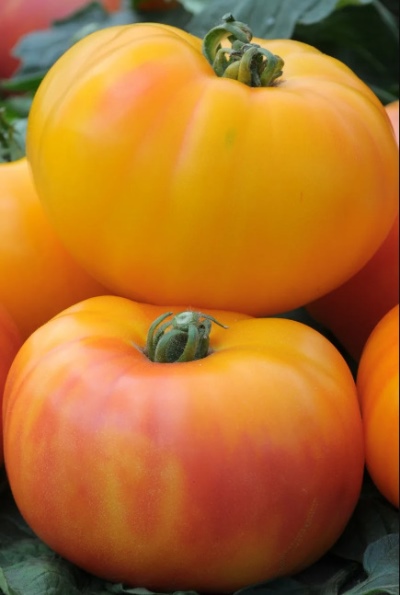
- Authors: Kachainik V.G., Gulkin M.N., Karmanova O.A., Bulykova N.V.
- Year of approval: 2017
- Category: grade
- Growth type: indeterminate
- Appointment: fresh consumption
- Ripening period: mid-season
- Ripening time, days: 115
- Growing conditions: for open ground, for film greenhouses
- Marketability: high
- Bush height, cm: 200-250
Divo belongs to indeterminate plants. This is a tall, early maturing variety up to two meters high. Spreading bushes, differ in the average filling of the deciduous crown. To achieve high yields, it is necessary to provide careful plant care, including formation, garter and pinching.
Breeding history
The Divo Divnoe tomato is an author's hybrid included in the State Register of the Russian Federation. Its authors are Olga Karmanova, Vladimir Kachainik, Mikhail Gulkin and Natalia Bulykova. The first generation (F1) tomato breeding company supplies the highest quality seeds. They are popular not only with ordinary summer residents, but also with large farms and vegetable farms.
Description of the variety
When grown in greenhouse conditions or under a film cover, the height of the bush, as a rule, is 200-250 centimeters. The leaves are of medium size and are distinguished by a bright green color, the root system is powerful. The varietal hybrid is stress-resistant, and also immune to diseases common for tomatoes (fusarium, tobacco mosaic and cladosporium). The first flower appears above the eighth leaf, after which the shoot releases inflorescences every three leaves.
Wonderful wondrous will be interesting not only for amateurs, but also for specialists. On specialized sites and forums, you can see a lot of photos and positive reviews from summer residents and farmers who appreciated the miracle of vegetable growing. All this suggests that the variety deserves attention. Despite the fact that the Marvelous tomato was introduced not so long ago, it has already been entered into the State Register. The variety can be found in the list of tomatoes for cultivation in greenhouses and under cover films.
The main qualities of the fruit
Tomato fruits are large, dense, flat-round in shape - with noticeable ribbing. They are famous for their strong aroma and attractive appearance. Unripe fruits have a light green tint, upon reaching maturity they are yellow. The pulp is fragrant, juicy. There are few seeds in the chambers.
Among the characteristics of the tomato are the weight of the fruit from 450 to 500 g. The tomato is ideal for making salads.
Taste characteristics
The fruit is fleshy, dense, juicy. Other characteristics:
light fruity aroma;
sweetish taste.
Ripening and fruiting
Approximately 115 days pass from germination to ripening. You can harvest the first crop already 100 days after the first shoots appear.
Tomatoes tolerate transportation well. It should be noted and the ability to maintain a marketable appearance, as well as taste in storage conditions for a month.
Yield
The variety is mid-season and has a high yield - an average of 10 kg per 1 square meter.
The timing of planting seedlings and planting in the ground
Sowing of seeds is carried out depending on the region and climate: in the northern regions 40-60 days before the end of spring frosts, and in the southern ones - 40 days. In addition, the planned planting time is taken into account, as well as the type of cultivation facility.

Growing tomato seedlings is an extremely important process, because it largely depends on whether the gardener will be able to harvest at all.All aspects must be taken into account, from seedbed preparation to planting in the ground.
Landing scheme
Seeds are usually sown in the second or third decade of March. Before germination, the soil must be kept under a film cover. The recommended temperature range is 22-24 ° C above zero. The pick is carried out in a 0.5 liter container. The hardening period is 1 week.
Tomatoes are planted at a distance of 45 centimeters. In this case, there should be at least 70-80 centimeters between the rows, and 80-100 centimeters between the ribbons. The result is approximately 3 bushes per 1 square meter.

Growing and care
Before planting seedlings in the greenhouse at a level of two meters, it is recommended to stretch the wire. Shoots must be planted strictly vertically, sprinkling the plants with soil a little. They should not be buried deep in the ground. After the entire crop is planted, it must be watered - the professionals advise the way to nourish. It will help not to stain the bushes that did not have time to get stronger and not to nail them to the ground.
An important step is the garter. It is carried out using a vertical trellis, forming a rope loop on the stem of the shoot. Then, every 7 days, the top of the shoot must be twisted around the twine, which was previously fixed on the stretched wire. In this case, it is imperative to remove the stepsons so that they do not grow more than 5 centimeters.
Watering the bushes by sprinkling is unacceptable - this leads to fungal diseases. Watering frequency depends on the condition of the shoots. The most important thing is to avoid wilting. Top dressing is also important in the cultivation of the Diva. During the formation of fruits, the concentration of nutrients must be increased by one and a half times. Do not forget about the airing of greenhouses, as well as about the fight against insect pests and diseases that tomatoes are susceptible to.




A plant needs different micronutrients at each stage of growth. All fertilizers can be divided into two groups: mineral and organic. Folk remedies are often used: iodine, yeast, bird droppings, eggshells.
It is important to observe the rate and period of feeding. This also applies to folk remedies and organic fertilizers.



























































































